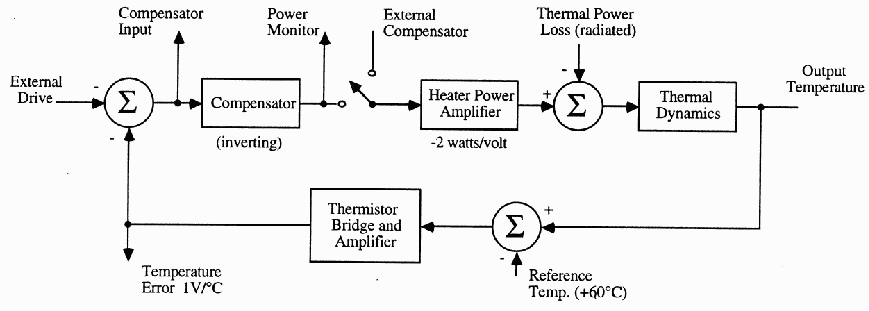
A functional block diagram of the temperature control system is shown in the figure. The temperature of the controlled surface of the thermal structure is sensed with a device whose resistance is a function of temperature. This device is called a thermistor. This thermistor forms one leg of a 4 element bridge. The bridge null temperature has been set to approximately 60°C, and this value is the system reference temperature. A differential amplifier connected to the bridge provides a linearized output of 1V/°C of temperature error. This signal is available externally to enable you to measure the dynamics of the thermal system. Provision to add an input to the error signal is also available. This test input is also used to evaluate thermal dynamics. The sum of the error signal and the test signal provide the input to the system compensation amplifier. The input and output points of the compensator are available along with a switch that disconnects the internal compensation amplifier. This combination allows you to use the compensator that you designed to close the loop. The output of the compensator is applied to a power amplifier that drives a heater located on the opposite surface of the plate on which the thermistor is mounted. The power amplifier is designed so that the heater power is linearly proportional to the voltage applied to its input. This type of amplifier is required since temperature and power are linearly related in thermal systems. The voltage at the power amplifier input is also available for use in evaluating loop dynamics. The scale factor that relates the voltage monitored to heater power is -2 watt/volt. Note that this monitor voltage is valid only when the internal compensation is being used. However, the scale factor of -2 watt/volt remains true when using external compensation. The thermal system loses power constantly through the uninsulated radiator plate. Since the ambient temperature and the temperature of the thermal structure remain essentially constant, this heat loss is constant. The net power applied to the thermal structure is the difference between the power delivered by the heater and the power lost through the radiator. The power lost via the radiator allows the system to either raise or lower temperature using only a controlled heater. |